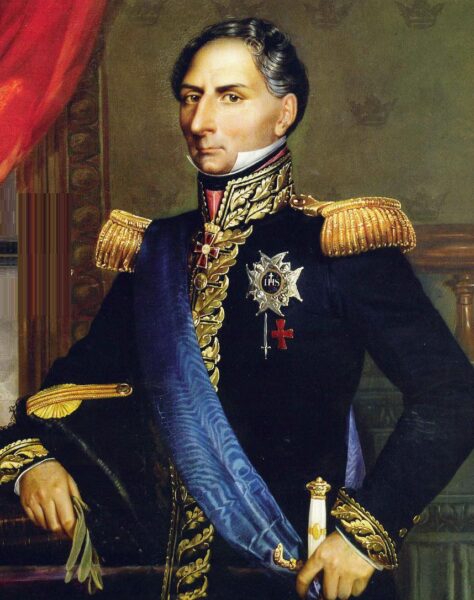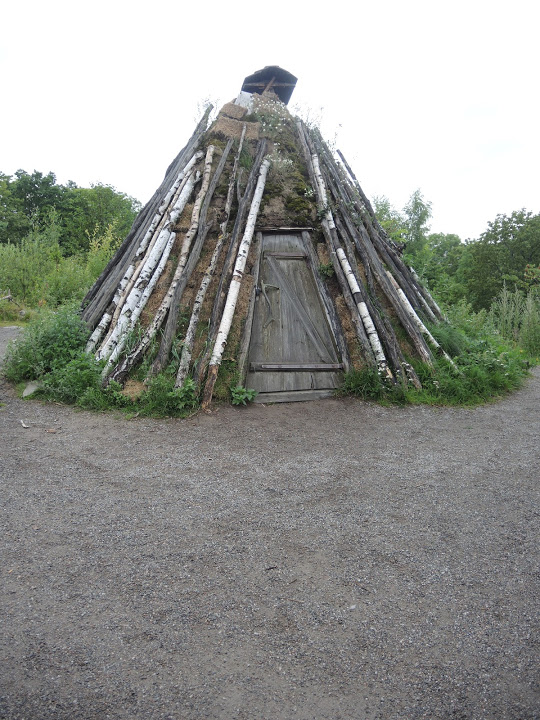The Sami farmstead.
One area of particular interest to me was the Sami farmstead. I first learned a little about the Sami when I saw a Russian film called Kukushka (or in English) The Cuckoo. The movie is comprised almost exclusively of the interactions of three characters – two soldiers – one Finnish and one Russian – who for various reasons find themselves outcast by and from their former compatriots and stranded on the farm of the third character – a single Sami woman who may be a widow or who may herself be an outcast. They don’t share any common language and, in this comedy of errors and miscommunication, the movie ends with a beautifully twisted punch line. It raised my curiosity about Sami culture.
Here’s a bit of what I learned. The Sami have long been known to most English speakers as Lapps or Laplanders. They are considered the only indigenous people of Scandinavia and are recognized and protected under the international conventions of indigenous peoples making them the northernmost indigenous people of Europe. Their ancestral lands cover an area of approximately 388,350 square kilometers over parts of current day Norway, Sweden, and Finland.
Traditionally, the Sami have pursued a variety of livelihoods, including coastal fishing, fur trapping, and sheep herding. However, they are best-known for being semi-nomadic reindeer herders. Today only about 10 percent of the Sami are connected to reindeer herding but this livelihood provides that group with meat, fur, and transportation.
When I finally reached the Sami area of Skansen, the architecture of their traditional dwelling surprised me just a bit.
While the materials are quite different – it’s a turf shelter that uses birch poles for support – the shape, of course, evokes the tipis of Native American plains and the door is similar to the gers of Mongolia. It made me wonder whether there’s any genetic evidence that relates the Sami to the people who crossed from Asia into the Americas and the direction such evidence would point.
Now, as we walk the four kilometers or so from Skansen back to Gamla Stan, I’ll fill you in on how the Frenchman Jean Bernadotte came to establish the current royal house of Sweden. It involves in order a war, a coup d’état, a childless senile king, an untimely death, and another war.
In the post “How Sweden it is!” I mentioned the Finnish war – a conflict between the burgeoning power of the Russian Empire and the withering strength of the Swedish Empire. King Gustav IV Adolph (and I have an interesting story I’ll share a bit later on about his father Gustav III) was probably guilty of mismanaging his troop deployment and Russia eventually handed Sweden a rather sound military defeat that culminated on 17 September 1809 with the Treaty of Fredrikshamn. In this document, Sweden ceded all of the territory of Finland, which it had controlled for seven centuries, to Russia.
You can probably guess that the Swedish nobility wasn’t particularly happy with this outcome and they demonstrated their displeasure by overthrowing both Gustav IV Adolph as well as his son Gustav. They turned to Gustav IV Adolph’s uncle who was at that time ruling in Norway as Charles II and who had served as regent in Sweden after the death of Gustav III before Gustav IV came of age.
Charles was 60 at the time and, though he had married a cousin from the Swedish ruling house of Holstein-Gottorp, had seen both his children die in infancy. He assumed the title of Charles XII of Sweden but it quickly became clear that he was growing ever dottier.

David von Krafft: Karl XII
[From Wikipedia – Public Domain.]
Faced with a childless senile King, the Riksdag of the Estates (the equivalent of the Swedish Parliament) elected a Danish prince, Prince Christian August of Augustenborg, as heir to the throne. Unfortunately, just a few months after becoming the crown prince of Sweden, Karl August, as he called himself, died of a stroke.
So, here’s the situation facing the Swedes in 1810. Their power is waning. They have a massive national debt because of the wars they’d recently lost. Their elected king is senile and childless, and the prince they’d elected as his heir had just dropped dead from a stroke. And, to top all that off, there’s this guy named Napoleon on the main European continent more or less conquering everything in sight.
Noticing that Napoleon appointed his brothers to rule in some of his client kingdoms, one member of the Riksdag, Baron Karl Otto Mörner, thought he knew just the right man for the job of king of Sweden – one Jean Baptiste Bernadotte. Napoleon had appointed Bernadotte as a Marshal of the French Empire in 1804 and he had served as governor in Hanover. He was very rich and his wife’s sister was married to one of Napoleon’s brothers.
Neither Napoleon nor the entirety of the Riksdag were particularly happy with Mörner’s bold move but both eventually shrugged and accepted his choice. On 21 August 1810 the Riksdag formally elected Bernadotte as the crown prince. A few months later, Bernadotte rode into Stockholm, accepted the offer of the Riksdag, was adopted by Charles XII, converted from Catholicism to Lutheranism and adopted the name Karl Johan.

[Portrait of Karl XIV John of Sweden AKA Jean Bernadotte – From Wikipedia – Public Domain.]
As Charles XII grew more senile, Bernadotte ruled as regent and quickly became quite popular because he personally paid off Sweden’s national debt and developed a foreign policy that centered on reacquiring Norway. It was Bernadotte who led the troops when Sweden defeated Denmark. That led to the Treaty of Kiel which ceded control of Norway to Sweden and re-created the union that lasted until 1905. He became Charles XIV of Sweden and Charles III of Norway in 1818 and established the House of Bernadotte that reigns in Sweden to this day.
We’ve finally arrived back in Gamla Stan and it’s time for dinner. Not knowing that the Grillska Huset closed at 18:00, I had to find another restaurant and chose one called De Svarta Fåren on the opposite side of Stortorget. I chose to sit outside on the square. The dinner was fine – a seafood stew accompanied by a half liter of Paulaner Hefe Weissbier – but was made memorable by first a massive rain storm that overflowed the awning and forced some of the diners to move inside and second by a rather bizarre conversation I had with a couple of heavily tattooed guys who fortunately love Americans and are tolerant of the Finns but pretty much disrespected everyone else – particularly Germans, Russians, and Danes – disparaging them all using heavily expletive laden language. I think they were saying this in fun and for the shock value.
Despite my disappointment in not getting to Abba the Museum, it was, all in all, a fun day.
Believe it or not, even more adventures in Stockholm await tomorrow before I depart on a Baltic cruise for Helsinki.
